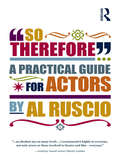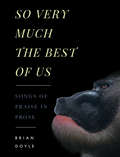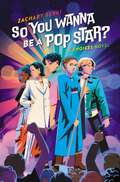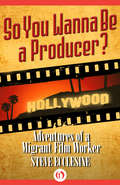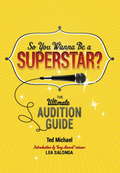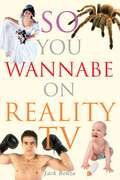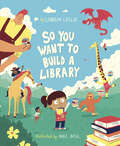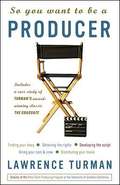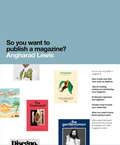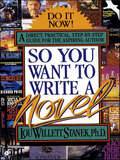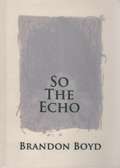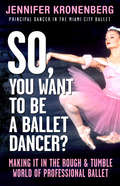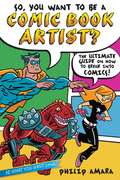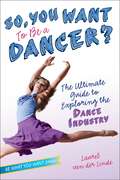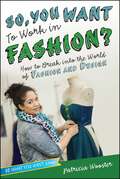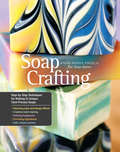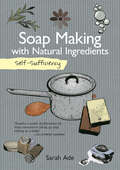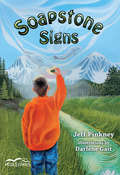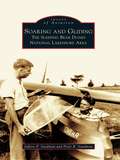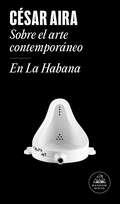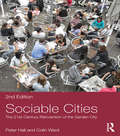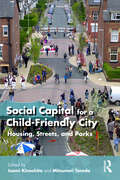- Table View
- List View
So Therefore...: A Practical Guide For Actors
by Al Ruscio‘Every scene or action or speech has a so therefore. It is the goal, the ultimate statement of the character. You should know the so therefore as you begin your scene ... The climax and the payoff is the so therefore.’ – from Al Ruscio’s Preface When working through a scene with a student, renowned actor and acting teacher Al Ruscio will ask, ‘so therefore, what?’ to urge them to capture the specific actions and desires that define their character at that moment. So Therefore… interweaves tried-and-tested practical exercises with sound advice, and illustrative tales from Ruscio’s remarkable career, to form a training handbook as uniquely pragmatic as his favourite phrase. Breaking down his method into three broad focuses, Ruscio considers: Warming Up – including relaxation, going ‘beneath the words’ and emotional recall; Scene Work – ranging from character analysis to an exploration of action; The Play – discovering its spine, progressing through rehearsals and sustaining a performance. But So Therefore… also reflects wisely on such diverse subjects as Stage versus Film, and Stamina, Luck and Chutzpah. Enriching and generous, it is the culmination of a career that has taken in dozens of major motion pictures, and spans the entire history of television – as well as half a century spent training actors. Al Ruscio graduated from the famed Neighborhood Playhouse School of the Theatre and has been teaching acting for five decades. He has served on the Board of Directors of the Screen Actors Guild and is a current voting member of the Academy of Motion Picture Arts and Sciences.
So Very Much the Best of Us: Songs of Praise in Prose
by Brian DoyleIs Brian Doyle the most passionate Catholic storyteller in America? Here is new evidence that he is. In this brand new compilation of some of his best stories that have appeared in various publications throughout the world, Doyle explores the promise of Catholicism in America that he has experienced and observed from his childhood through today.
So You Wanna Be A Pop Star?: A Choices Novel
by Zachary SergiAn energetic, interactive YA novel about five solo pop artists navigating drama, finding their sound, and discovering what it truly takes to chase their dreams of music stardom after being forced into a pop group together. Everly Brooks knows she has what it takes to be the next big singer-songwriter. At least, that's if she could get her onstage presence to stop feeling so wooden and blossom like her rich, moving lyrics. The reality signing competition, SO YOU WANNA BE A POP STAR? is her chance at proving to the world—and herself—that her talent and artistry can mean something more than just live streams and online videos. Vinny Vecchi thought he was heading toward a life full of makeup, wigs, and werking it on the drag stages of NYC. But a powerful diva voice is a precious thing to waste and, in need of money to make his drag dreams come true, SO YOU WANNA BE A POP STAR? is the next best thing. However, surrounded by competitors with clear brands and sharpened musical identities, he wonders if he can break through while still discovering himself. When a group performance on the show goes viral overnight, Everly and Vinny find their careers unexpectedly tied together. Along with their competitors—influencer Dea Seo, pop-punk CeCe Winnifred, and heartthrob Stern Green—these five artists are forced to become the newest pop super group: Jeweltones. You, the reader, get to make choices that will make or break Everly, Vinny, and the group&’s meteoric rise in this interactive novel. Will you mend the cracks to help Jeweltones shine bright, or will they burn out under pressure? The choices are yours to make!
So You Wanna Be a Producer?
by Steve EcclesineProducer Steve Ecclesine has boiled down more than thirty years and over seven hundred shows as an independent Hollywood producer into one book So You Wanna Be a Producer? features one hundred thirty essays on a wide variety of subjects, as well as a complete budget for anyone seriously considering jumping into the shark tank. Used in dozens of film schools worldwide, So You Wanna Be a Producer? is a boy scout's handbook for anyone interested in show business. Also included is Ecclesine's second book, Adventures of a Migrant Film Worker, which tells hair-raising tales of what it's like working inside the belly of the beast.
So You Wanna Be a Superstar?: The Ultimate Audition Guide
by Ted MichaelGeared toward hopeful musical theater, show choir, a cappella, and glee club singers, as well as all shower singers that want to improve their skills, this enthusiastic and practical guide can help anyone's inner superstardom make a public appearance. <P><P>Full of straightforward, well-organized advice for every step of the process, this book will help you train your vocal cords, pick the right audition material, and become comfortable with the spotlight. Interactive quizzes, helpful sidebars, and words of advice from industry professionals add a personalized and real-world touch. Author Ted Michael, a veteran of music and theater, along with the help of popular actors, actresses, and singers, provides all the tools young singers need in order to nail their auditions and nurture their natural show-stopping abilities.
So You Wannabe on Reality TV
by Jack BenzaThere are more than two hundred reality TV shows planned for this year alone. Millions of people have applied to be on these shows; only a handful have been chosen to compete and win big money. One of those chosen few is Jack Benza, and in So You Wannabe on Reality TV he lifts the veil of secrecy to reveal exactly what the experience is like-how to get cast, how to stay on top, how to win. First, the author tells exactly how to pass the audition-perhaps by creating a marketable "alter ego," as he did. Once on the show, readers will need the amazing information on how producers rig shows, how cameras turn into confessionals, and how sex and alcohol are used as rewards. This one-of-a-kind book shows the real world of reality TV.
So You Want To Build a Library
by Lindsay LeslieThere is no better place in the world than a library. Especially a library that kids create! A million stories high? Sure. Bathtubs? Absolutely. A full-service sundae bar? Of course. Everything is possible in this library—just like in books! Author Lindsay Leslie puts the reader in charge as the architect of a fantastical library in this imaginative picture book celebrating libraries and the joys of reading.
So You Want to Be a Producer
by Lawrence TurmanFew jobs in Hollywood are as shrouded in mystery as the role of the producer. What does it take to be a producer, how does one get started, and what on earth does one actually do? In So You Want to Be a Producer Lawrence Turman, the producer of more than forty films, including The Graduate,The River Wild,Short Circuit, and American History X, and Endowed Chair of the famed Peter Stark Producing Program at the University of Southern California, answers these questions and many more. Examining all the nuts and bolts of production, such as raising money and securing permissions, finding a story and developing a script, choosing a director, hiring actors, and marketing your project, So You Want to Be a Producer is a must-have resource packed with insider information and first-hand advice from top Hollywood producers, writers, and directors, offering invaluable help for beginners and professionals alike. Including a comprehensive case study of Turman's film The Graduate, this complete guide to the movie industry's most influential movers and shakers brims with useful tips and contains all the information you need to take your project from idea to the big screen.
So You Want to Publish a Magazine?
by Angharad LewisThe process of creating graphic design cannot be easily defined: each designer has their own way of seeing the world and approaching their work. Graphic Design Process features a series of in-depth case studies exploring a range of both universal and unique design methods. Chapters investigate typical creative strategies – Research, Inspiration, Drawing, Narrative, Abstraction, Development and Collaboration – examining the work of 23 graphic designers from around the world. Work featured includes projects by Philippe Apeloig, Michael Bierut, Ed Fella, James Goggin, Anette Lenz, Johnson Banks, Me Company, Graphic Thought Facility, Ahn Sang-Soo and Ralph Schraivogel. This book is aimed at students and educators, as well as practising designers interested in the working methodologies of their peers.
So You Want to Publish a Magazine?
by Angharad LewisThe process of creating graphic design cannot be easily defined: each designer has their own way of seeing the world and approaching their work. Graphic Design Process features a series of in-depth case studies exploring a range of both universal and unique design methods. Chapters investigate typical creative strategies – Research, Inspiration, Drawing, Narrative, Abstraction, Development and Collaboration – examining the work of 23 graphic designers from around the world. Work featured includes projects by Philippe Apeloig, Michael Bierut, Ed Fella, James Goggin, Anette Lenz, Johnson Banks, Me Company, Graphic Thought Facility, Ahn Sang-Soo and Ralph Schraivogel. This book is aimed at students and educators, as well as practising designers interested in the working methodologies of their peers.
So You Want to Write a Novel: A Direct, Practical, Step-by-Step Guide for the Aspiring Author
by Lou Willett StanekYou know there is a novel locked inside of you—chock-full of conflict, humor, irony, enthralling events and fascinating characters. What you don't know is how to set it free.Practical Advice, Hands-On HelpRespected author and professional writing instructor Lou Willett Stanek's New York workshops have enabled scores of aspiring novelists to realize their dreams of completing credible and compelling manuscripts. Here, in a positive, "user-friendly" format, she offers not only encouragement and motivation, but Clear, Step-By-Step Instructions To Accomplish Your Goal—from original conception through final draft.Learn How To: Set up and stick to a writing schedule Create unforgettable characters Follow strong plotting and solid structure guidelines Choose a viewpoint and develop conflict Handle flashbacks and transitionsNot Just Philosophy Or A Simple Motivational Tool, This Is The Book That Tells You How To Succeed
So the Echo
by Brandon Boyd Shana Nys DambrotSo The Echo (Endophasia Publications, Hardcover, $49.99 ), Brandon Boyd's third book visually weaves recent years of his creative life as he spent much time honing his craft, displaying his work and using his visual art as a tool for activism. Beautifully designed in 156 pages, the book reveals many new sketches with watercolor and other experimental techniques, as well as very personal photos and journal entries, most often written as observations while travelling the world with his band mates in Incubus. Upon the book's release Brandon hosted book signings and artist talks in several cities both nationally and internationally.
So, You Want to Be a Ballet Dancer?: Making It In The Rough And Tumble World Of Professional Ballet
by Jennifer Carlynn KronenbergIs everything really so beautiful at the ballet? For Miami City Ballet principal dancer Jennifer Carlynn Kronenberg it is; but it wasn’t always so. Learn how she made it through all of her high jinx mishaps, missteps, and tribulations, and continued on to a glorious career as a prima ballerina with an internationally acclaimed ballet company. <P><P> Kronenberg shares her memoirs, hints, tips, and professional advice for aspiring dancers and their parents, hoping to ease them through the hard years of study as well as through the abrupt and challenging transition from student to professional. Covering everything from choosing a school and auditioning, to stage makeup and backstage basics, this books provides the answers young dancers need to help them survive in today’s challenging ballet world.
So, You Want to Be a Comic Book Artist?: The Ultimate Guide on How to Break Into Comics! (Be What You Want)
by Philip AmaraFind success as a comic book artist with this step-by-step guide to creating, publishing, and marketing your very own comics.The secrets to comic book creation are at your fingertips! This comprehensive guide details the steps to becoming a hit comic book maker—from creating compelling characters and illustrations to getting published and marketing a finished product—and is full of insights from world-famous artists from such companies as DC, Marvel, and Dark Horse. In addition to highlighting tips from seasoned pros, inspiring success stories from young artists are sprinkled throughout along with a resource list of potential publishers to help you hit the ground running. So, You Want to Be a Comic Book Artist? also features in-depth chapters on adapting a storyline for video games and movies, using social media to promote a finished product, and self-publishing your own comic. Whether you’re just starting out or have been drawing comics for years, this book will get you where you want to go.
So, You Want to Be a Dancer?
by Laurel van der LindeLove dance? Go pro and make movement a way of life with this comprehensive guide that can help you land your dream job in the world of dance.From front-and-center careers like professional dancer and choreographer to the lesser-known professions of technical director and costume designer, So, You Want to Be a Dancer? reveals a vast expanse of dance-related job possibilities that are as exciting as they are rewarding. In addition to tips and interviews from many different dance industry professionals, So, You Want to Be a Dancer? includes inspiring stories from young people who are in the industry right now, as well as activities, a glossary, and resources to help you on your way to a successful career in dance.
So, You Want to Work in Fashion?: How to Break into the World of Fashion and Design (Be What You Want)
by Patricia WoosterHave a passion for fashion? This comprehensive guide can help you land your dream job in the world of fashion and design.Fashion is more than fun--it holds a wide array of career opportunities! From high-profile jobs like clothing designer, model, and fashion photographer to the not-so-well-known professions of fabric cutter and colorist, So, You Want to Work in Fashion? explores a wide world of possibilities that are thrilling and fulfilling. In addition to tips and interviews from a variety of fashion professionals, So, You Want to Work in Fashion? includes inspiring stories from young people who are in the industry right now, as well as activities, a glossary, and resources to help you on your way to a successful career in fashion.
Soap Crafting: Step-by-Step Techniques for Making 31 Unique Cold-Process Soaps
by Anne-Marie FaiolaMake your own custom-tailored and perfectly formed cold-process soaps! Learn how to use milk jugs and yogurt containers for molds, and how coffee, avocado, and even beer can add unique dimensions to your creations. This encouraging introduction to the art of soapmaking makes it simple to master the techniques you need to safely and easily produce your own enticingly fragrant soaps.
Soap Making with Natural Ingredients
by Sarah AdeA comprehensive guide to making all-natural, artisanal soaps and bath products from the director of The BareNaked Soap Company.This practical book is full of helpful advice on how to make your own luxurious and beautiful soaps at home, using only the best natural ingredients. Not only are these soaps good for you, they also look great, feel great, and make wonderful gifts!Soap-making entrepreneur Sarah Ade introduces all the simple techniques and basic kitchen equipment you'll need to create an array of gorgeous soaps. You'll learn how to choose your ingredients, understand their properties, and put them together to achieve a specific purpose.Dozens of easy-to-follow recipes range from the fun and frivolous to sensible and serious, and the text is packed with ideas for alternative soap making and homemade skin care. This is an essential guide for anyone interested in what they put onto their body as well as what goes inside.
Soapmaking for Fun and Profit
by Maria NeriusThe author includes tips for cold-process soap-making, using essential oils safely, setting up your work area, marketing and selling your product, and managing the business.
Soapstone Signs (Orca Echoes)
by Jeff PinkneyOne spring, a nine-year-old Cree boy is visited by a master soapstone carver named Lindy, who gives him four pieces of soapstone. The primary secret to carving, the boy learns, is recognizing that each piece of soapstone already holds its true form inside. Lindy teaches the boy to listen to the soapstone and look to the world around him for signs as to what to carve. As the seasons change, the young boy’s experiences lend him opportunities to develop his carving skills and become attuned to the signs around him. He eagerly awaits the following spring, which will bring Lindy’s return and a chance to show off his carvings. The epub edition of this title is fully accessible.
Soapylove: Squeaky-Clean Projects Using Melt-and-Pour Soap
by Debbie ChialtasMelt & Pour and so much more! Soapylove shows you how to turn a glycerin melt-and-pour soap base into tempting, stylish soaps. You'll learn fun and easy techniques for 25 yummy projects featuring bright colors, amazing designs and delicious scents. Glycerin melt-and-pour soap is very easy to use - a microwave or stovetop is all you need! There is no messy boiling or complicated mixing. Techniques not yet found in any glycerin soap project book, including how to make cameos, plaid patterns, soap pops and even jelly donut soaps. The ins and outs of melt-and-pour soap supplies, allowing you to experiment with your own style. So come on in and start creating - you're bound to "Feel the love!"
Soaring and Gliding: The Sleeping Bear Dunes National Lakeshore Area (Images of Aviation)
by Jeffery P. Sandman Peter R. SandmanTo fly as the hawk and eagle has been mankind's dream for centuries.Modern sailplanes make soaring and gliding flight possible, and with them, humans can fly higher, faster, and farther than the greatest of birds, using only an invisible force of nature to stay aloft. The terms soaring and gliding are used interchangeably, and the sport is appealing to pilot and spectator alike. Sailplane enthusiasts have always been explorers, always looking for a more ideal site that will provide the intellectual challenges of soaring as well as the sheer beauty and relaxation the sport can offer. Michigan-based glider pilots and designers found their soaring paradise in the early 1930s when they ventured north to the Sleeping Bear Dunes area. The explorers began to promote the sport to national and international prominence, and many came to make up a veritable who's who of American aeronautics. Over a century after Octave Chanute discovered motorless flight on the Lake Michigan dunes, sailplanes, hang gliders, and paragliders still fill the skies.
Sobre el arte contemporáneo / En La Habana
by César AiraPremio Formentor 2021 Dos lúcidos y locuaces ensayos que abordan el proceso de creación artística en el campo de la literatura y de las artes visuales, así como el lenguaje que se esconde detrás de las piezas de museo. Premio Iberoamericano de Narrativa Manuel Rojas 2016. Los dos ensayos que integran este volumen fueron escritos con una década de diferencia. Sobre el arte contemporáneo es la alocución con la que César Aira inauguró el congreso Artescritura, que tuvo lugar en Madrid en 2010 y que se proponía como objetivo superar la brecha que separa a escritores y a artistas visuales. En La Habana, en cambio, parte de un recorrido por la casa museo del escritor Lezama Lima, realizado durante una visita a Cuba en el año 2000, y desemboca en una crónica del viaje por los museos de la ciudad y los objetos que allí se exponen. Estos dos imponentes textos de uno de los autores clave de las letras hispanas vuelven a incidir en algunos de los temas predilectos de Aira: la relación entre arte y literatura, el proceso de creación, el arte de lo incompleto y, en definitiva, la veracidad de la escritura.
Sociable Cities: The 21st-Century Reinvention of the Garden City (Planning, History and Environment Series)
by Colin Ward Peter HallPeter Hall and Colin Ward wrote Sociable Cities to celebrate the centenary of publication of Ebenezer Howard’s To-morrow: A Peaceful Path to Real Reform in 1998 – an event they then marked by co-editing (with Dennis Hardy) the magnificent annotated facsimile edition of Howard’s original, long lost and very scarce, in 2003. In this revised edition of Sociable Cities, sadly now without Colin Ward, Peter Hall writes: ‘the sixteen years separating the two editions of this book seem almost like geological time. Revisiting the 1998 edition is like going back deep into ancient history’. The glad confident morning following Tony Blair’s election has been followed by political disillusionment, the fiscal crash, widespread austerity and a marked anti-planning stance on the part of the Coalition government. But – closely following the argument of Good Cities, Better Lives: How Europe discovered the Lost Art of Urbanism (Routledge 2013), to which this book is designed as a companion – Hall argues that the central message is now even stronger: we need more planning, not less. And this planning needs to be driven by broad, high-level strategic visions – national, regional – of the kind of country we want to see. Above all, Hall shows in the concluding chapters, Britain’s escalating housing crisis can be resolved only by a massive programme of planned decentralization from London, at least equal in scale to the great Abercrombie plan seventy years ago. He sets out a picture of great new city clusters at the periphery of South East England, sustainably self-sufficient in their daily patterns of living and working, but linked to the capital by new high-speed rail services. This is a book that every planner, and every serious student of policy-making, will want to read. Published at a time when the political parties are preparing their policy manifestos, it is designed to make a major contribution to a major national debate.
Social Capital for a Child-Friendly City: Housing, Streets, and Parks
by Isami Kinoshita Mitsunari TeradaSocial Capital for a Child-Friendly City argues for the importance of relationship networks (social capital) in children’s growth and socialization, and explores how child-friendly social capital can be cultivated through urban planning and community development. As outdoor play decreases and children spend more time online, Kinoshita and Terada return to John Dewey’s proposal that social capital is essential for nurturing the next generation and establish a democratic and sustainable society. The book features examples from Sweden, Finland, Germany, Switzerland, the UK, and Japan, exploring methods for cultivating social capital and spaces for children to play and develop in cooperative housing, outdoor play spaces, streets, parks, and neighbourhoods. We express our gratitude to Dr. Marketta Kytta, Professor of Aalto University, who gave valuable suggestions about the key term ‘bullerby’ and ‘social capital’.This book will be of use to students and practitioners of urban planning and landscape architecture, as well as any community leaders or developers seeking to foster a nurturing environment where children can flourish.
